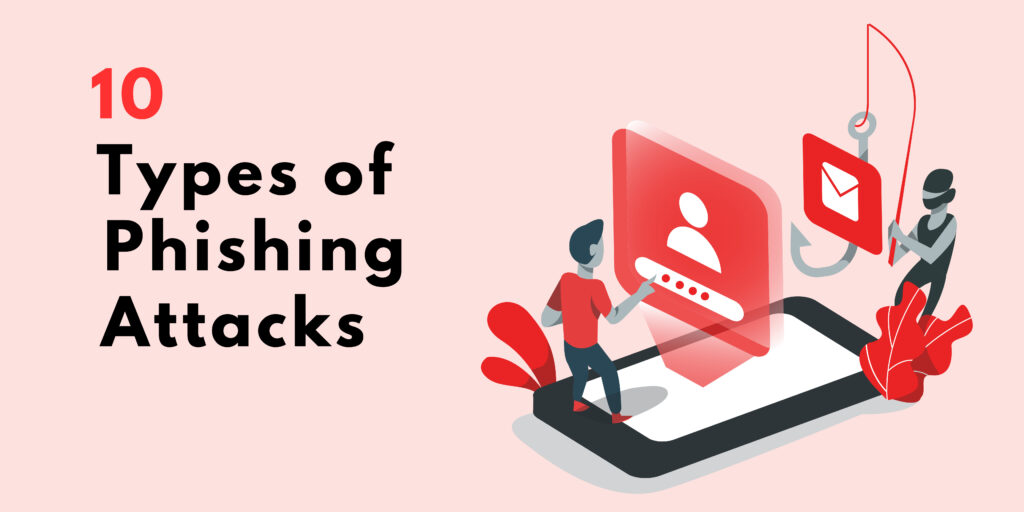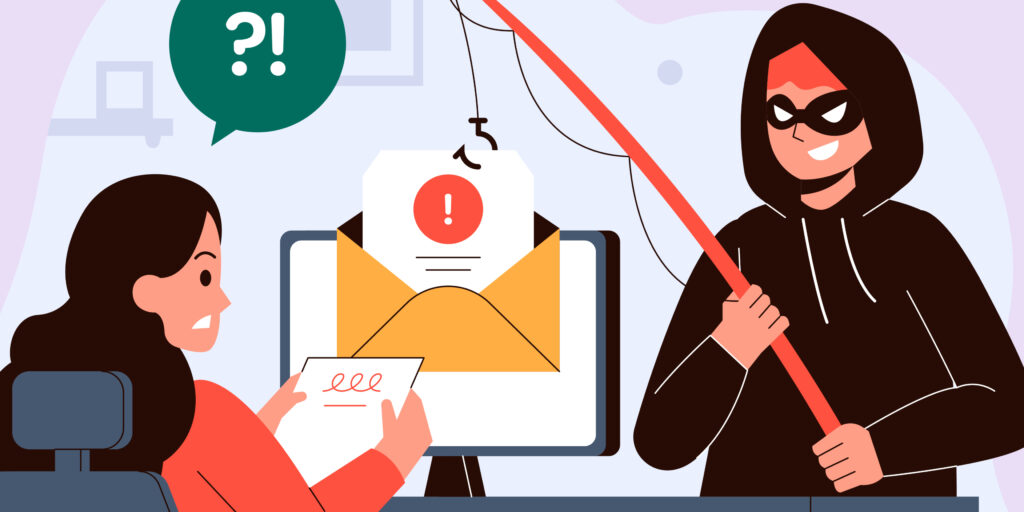10 Types of Phishing Attacks and How to Prevent Them 2023

Phishing attacks involve fraudulent communications, often via email, masquerading as reputable sources. The aim is to deceive recipients into revealing sensitive data or installing malware on their devices.
There are numerous types of Phishing Attacks, the 10 types of Phishing Attacks are mentioned below
Table of Contents
What are the different types of Phishing Attacks?
There are different types of Phishing Attacks. Some of the types of Phishing Attacks are mentioned below.

1. Deceptive Phishing
Deceptive phishing is the most common type of phishing attack, in which attackers send emails that appear to come from a legitimate source, such as a financial institution or a social media site. The email may contain a link that takes the user to a fake website that looks identical to the legitimate site. The user is then asked to enter sensitive information, like login credentials or credit card numbers, which the attacker can then use to get into the user’s account. Hackers spam emails impersonating a bank’s security department to trick users into revealing bank account details is an example of deceptive phishing. Beware of such scams!
2. Spear Phishing
This type of phishing attack is much more targeted than general phishing attacks. The attacker will often have specific information about the victim, such as their name, job title, or company. makes the email appear more legitimate and increases the chances that the victim will click on a malicious link or attachment. The attacker will send an email that appears to come from a legitimate source, but the email will contain a link that leads to a fake website. The fake website will ask the user for sensitive information like credit card numbers or login information. The attacker can then use this information to gain access to the user’s account and is known as Spear phishing
3. Whaling
Whaling attacks are similar to spear phishing, but they target high-profile individuals such as CEOs, CFOs, or other executives. Most of the time, these attacks start with a very convincing email that looks like it came from a real source, like the government or a bank.
4. Vishing
Vishing is a type of phishing attack that uses voice calls or VoIP (Voice over IP) instead of email. The attacker will try to trick the victim into giving them personal information or financial data over the phone. Automated voice messages impersonate legitimate institutions like banks or government entities is an example of this type of phishing attack. Beware!
5. Smishing
Smishing is a type of phishing attack that uses SMS (Short Message Service) texts instead of email. The attacker will send a text message that appears to be from a legitimate source, such as a bank or government agency. They will then try to trick the victim into giving them personal information or financial data.
6. Clone phishing
Clone Phishing is a type of phishing attack where the attacker creates an exact replica of a legitimate email that has been sent previously. In clone phishing, the only difference is that the malicious link or attachment has been replaced with a new one. This can be difficult to spot, especially if the victim doesn’t have the original email to compare it to.
For more understanding, you can read: How to identify a phishing email
7. Typosquatting
It is a type of phishing attack, the attacker uses a domain name that is strikingly similar to one of the addresses of a reliable website. When victims attempt to access the legitimate site but make a typo, they are taken to the attacker’s bogus website instead. The attacker may then attempt to dupe the victim into providing them with personal or financial information.
8. Pharming
The type of phishing attack which involves sending victims to a fake website even when they type in the correct URL is pharming. This can be accomplished by using browser hijacking software or by infecting DNS servers. After that, the attacker tries to trick the victim into providing them with personal or financial information.
9. Malware-based phishing
Malware-based phishing is a type of phishing attack where the attacker uses malware to infect the victim’s computer. The malware can then be used to steal personal information or financial data.
10. Password Reset phishing
This type of phishing attacks posing as emails offering to reset a user’s password are called “password reset phishing.” The goal of this attack is to get private information from the user, like their username and password.

What are the ways to prevent phishing attacks?
There are different ways to prevent phishing attacks which one are required to keep in mind.
- User Education: Train users on phishing risks and best practices.
- Verify Sender Emails: Double-check email addresses for authenticity.
- Hover Over Links: Preview URLs to ensure legitimacy.
- Enable MFA: Use Multi-Factor Authentication for added security.
- Install Reputable Antivirus: Protect against malware and phishing attempts.
- Keep Software Updated: Regularly update OS, browsers, and security tools.
- Use Email Filters: Block suspicious emails and attachments.
- Secure Websites: Ensure HTTPS and avoid sharing sensitive info.
- Conduct Security Training: Regularly educate users on cybersecurity.
- Report Suspected Phishing: Encourage reporting to IT or the security team.
Except the above-mentioned point, you can also run the phishing attack simulation by looking to our guide on how to design a phishing simulation campaign.
You can also read: 10 tips to be safe from phishing attacks
Conclusion
In conclusion, phishing attacks continue to pose significant threats to individuals and organizations worldwide. With various sophisticated techniques at their disposal, cyber-criminals exploit human vulnerabilities to deceive and manipulate victims into divulging sensitive information or falling victim to malicious schemes. Understanding the different types of phishing attacks, from classic email phishing to more targeted and advanced approaches like spear phishing and whaling, is crucial in building a robust defense against these cyber threats. Vigilance, education, and the use of security measures can help individuals and businesses protect themselves from falling prey to these deceitful tactics. Remember, staying informed and adopting best practices are key to safeguarding against the ever-evolving landscape of phishing attacks in the digital age.
For further details related to the types of phishing attacks, you can read 25 types of phishing attacks.
FAQs
What are common phishing attacks?
Social engineering, email spoofing, bogus websites, and Vishing phishing are all common phishing attacks. They intend to steal private data.
What is group phishing?
Group phishing is a type of phishing attack where multiple individuals or targets within an organization are targeted simultaneously to steal sensitive information.
What are the example of a clone phishing attack?
Clone phishing examples involve duplicating legitimate emails, websites, or social media profiles to deceive recipients into providing sensitive information or downloading malware.
What type of phishing attack targets particular individuals?
Spear phishing targets specific individuals or groups, using personalized information to craft deceptive messages, increasing the likelihood of successful cyber-attacks or data breaches.
What are two common types of phishing?
Two common types of phishing are email phishing, which uses fraudulent emails to deceive recipients, and phishing websites that mimic legitimate sites to steal personal information.






